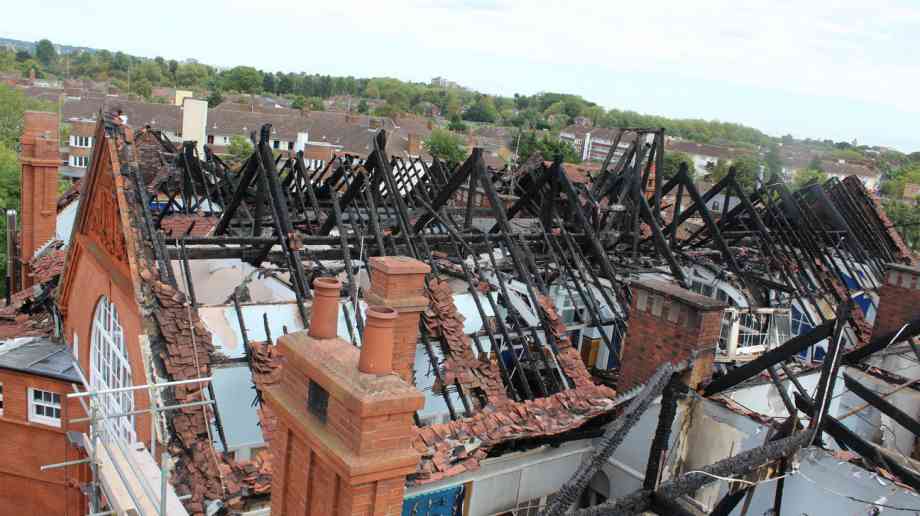
Improving the resilience of schools at high fire risk
Schools in England are nearly twice as likely to suffer a blaze than other types of commercial building, which has led to the launch of a parliamentary petition urging MPs to change the law on sprinklers in schools
A new study from Zurich Municipal reveals 480 primary and secondary schools endured fires in 2019, that’s 40 incidents every month. As a result, almost 20,000 school children have had their education impacted or have been displaced from their usual school building over the same period. The research was compiled by the Zurich data science team through a freedom of information request to the UK Fire and Rescue Services.
Further data analysis by Zurich shows that last year over 15,000m² of classroom space was damaged during blazes last year across 271 primary and 209 secondary schools.
Only two per cent (seven) of the schools had sprinkler protection in place. According to official figures, only 15 per cent of all new schools built and open in the UK since 2011 have been fitted with sprinklers. Whilst sprinklers are compulsory in all new or major refurbished school buildings in Scotland and Wales, this is not the case in England.
Firefighters have been called to nearly 2,000 school blazes in England alone in the last three years. Malfunctioning appliances or equipment, faulty electrics, arson and kitchen blazes are among the leading causes of school fires. Larger fires in schools cost on average £2.8 million to repair and in some cases over £20 million.
Greater risk of fire
Schools in England are nearly twice as likely to suffer a blaze as other types of commercial building. Zurich analysed the fire risks posed by 26,866 primary and secondary schools in England. It found the average school posed a fire risk 1.7 times greater than non-residential buildings (with a fire risk score of 0.58 and 0.33 respectively according to Zurich’s model).
When compared to 2.9 million non-household properties, schools were also three times more likely to fall into the “high” fire risk category (58 per cent vs 20 per cent), as defined by the study.
Data scientists analysed 33,000 fires from the last six years to identify factors that increase the likelihood of a blaze from which they produced a fire risk score. These factors include listed status, presence of cooking equipment and size of the building itself.
Bigger and older schools, including those with a canteen, and secondary schools – which have more complex and dangerous equipment – were identified as particularly at risk.
A correlation between poor Ofsted ratings and greater risk of fire was also identified in the analysis.
Despite being far riskier than average property when it comes to fires, many schools also lack the equipment and adequate fire protection needed to prevent small fires becoming major disasters. Of more than 1,000 school inspections carried out by Zurich, two thirds (66 per cent) were rated as having ‘poor’ fixed fire protection systems, such as sprinklers, which are proven to significantly reduce the damage caused by fire. Just 14 per cent were rated ‘good’ or ‘excellent’. A further quarter (24 per cent) were judged ‘poor’ for fire detection measures, such as smoke detectors and fire alarms.
Designing in fire safety
In June, Boris Johnson pledged £1bn to fund a decade long school rebuilding and repair programme and a further £560m in early August. Based on large fires alone, Zurich estimates that the repair for school fires could hit £320 million over 10 years – a significant portion of the government’s investment. Zurich wants the government to ring-fence some of its promised investment to improve the resilience of schools at high risk of fire.
The findings have also led Zurich to launch a parliamentary petition to urge MPs to change the law on sprinklers in schools.
Tilden Watson, head of education at Zurich Municipal, said: “With children’s education already severely impacted by the Covid-19 pandemic, the last thing we need is further disruption as a result of preventable school fires. As insurers, we work closely with schools to help them manage their fire risks but a simple solution such as the installation of sprinklers could minimise the dangers from the outset, avoiding months or even years of upheaval while the repairs are being carried out. It also preserves the community space, for which schools are often used out of hours.
“As well as protecting pupils, sprinklers drastically reduce the extent of damage when there is a blaze, often confining the fire to a single room. This gets children back into schools and classrooms quicker as well as saving taxpayers’ money so why is the government not willing to make this investment now, minimising the impact on our children, potentially saving lives and millions of pounds in repair costs?”
Andy Dark, Fire Brigades Union assistant general secretary, commented: “The poor standard of fire safety provision in our schools is nothing short of a scandal. A major feature of this failure to invest is the lack of sprinklers. It makes clear and unchallengeable economic sense to have sprinklers fitted; it has huge support amongst teachers and parents and has universal support amongst fire service professionals and the wider fire community. It is impossible to imagine why the Government has dragged its heels on this issue.
“Raising the level of fire protection and prevention in schools ticks all the boxes: protecting the education of students; protecting the community assets which the school infrastructure provides; reducing the damage caused by smoke and fire; and reducing the risks to both school-users and the firefighters who are called upon to extinguish the fires. It’s time for the government to stop prevaricating. It’s time for MPs of all parties to press for the government to urgently introduce the mandatory fitting and retro-fitting of sprinklers in all schools.”
Sprinklers save Flintshire school from ‘laser cutter’ blaze
Connah’s Quay High School in Flintshire, north Wales, was saved from a potentially disastrous blaze when a laser-cutter caught fire. Around 1,000 pupils had to be evacuated at lunchtime when the fire broke out at the secondary school in June 2019. The school’s sprinkler system quickly extinguished the fire and contained the damage to a single room allowing pupils to return the next day.
Emma Dale, Connah’s Quay school business manager, said: “Without sprinklers, the damage could have been devastating.
“Sprinklers are a cost saving measure, not an expense. They save the cost of rebuilding and repairing schools, and can pay for themselves in lower insurance premiums.”
Speaking at the time North Wales Fire and Rescue Service, said: “This incident clearly highlights the importance of sprinklers in helping to avoid the spread of fire.”
Further calls for sprinklers
Following the second school fire to affect Derbyshire in a 48 hours period and the third school fire in the county since May, the government has been further urged to take action and change fire safety legislation that would see all new build and refurbished schools fitted with sprinklers as mandatory.
The calls come from Derbyshire’s Chief Fire Officer/Chief Executive (CFO) Gavin Tomlinson, who is also the National Fire Chief Council Lead for Sprinklers.
A further five schools have been affected by fire in Derbyshire since April 2019.
CFO Tomlinson said: “It is absolutely heart breaking to see the devastation caused by fire at two Derbyshire schools over the last 48 hours.
“The effect that losing a school has on the community is huge. A school is right in the heart of a community, providing our children with the education they need, so to see this taken away at a time when schools are just starting to recover following Covid lockdown restrictions, is both a huge shock and totally unacceptable when there are fire safety measures that can prevent such devastation.
“Over the last few years, through the National Fire Chiefs Council, we have been calling for government to make changes to fire safety legislation that would see sprinklers fitted as mandatory in all new build and refurbished schools.
“Sprinklers are one of a range of fire safety measures that would not only protect our schools from fire and prevent injuries, but they would also protect against costly rebuilds and of course, protect against the stress and anxiety caused to the children who need their education.”
CFO Tomlinson went onto say: “I am not sure what more evidence is needed to bring legislation in line with Scotland and Wales where it is mandatory for sprinklers to be fitted and for the government here in England to take notice and more importantly, to take action – we have a responsibility to build safer schools.”
NFCC Chair Roy Wilsher said: “England is lagging behind Scotland and Wales when it comes to introducing legislation to fit sprinklers in schools. NFCC believes all new schools – and those undergoing refurbishment – should have automatic fire suppression systems fitted.
“In our response last year to the ‘Technical Review of Building Bulletin 100: Design for fire safety in schools,’ we highlighted that the rate of schools being fitted with sprinklers may have fallen from 70 per cent to as low as 15 per cent of new builds.
“We have a responsibility to ensure buildings are safer; sprinklers in schools is clearly a move in the right direction. Children across the UK have had their education severely disrupted this year due to the pandemic; a fire in a school will only make this worse, putting additional pressure on the education service and parents.
Wilsher also pointed out that schools are important community assets which need to be protected. He emphasised the importance of ensuring fire safety remains a key priority during the pandemic and to make it part of the COVID-19 secure planning, along with revisited escape routes and fire drills.
Latest News
31/10/2025 - 10:12
A growing number of UK children are now eligible for Free School Meals (FSM), yet most still aren’t taking advantage of them on a daily basis, new research reveals.
30/10/2025 - 01:28
In the wake of the Raac crisis, the DfE spent £5 million on research into the condition of school buildings, which is due to conclude in spring 2026.
30/10/2025 - 01:09
Malmesbury Primary School in Wiltshire has submitted plans for a major expansion, funded by entrepreneur James Dyson.
30/10/2025 - 00:55
Monday's Every Pair Tells a Story campaign to protest to highlight the national crisis in SEND provision.
29/10/2025 - 09:19
Estimated data from the Department for Education reveals that 470,000 pupils under 16s use local authority funded transport to get to school.







